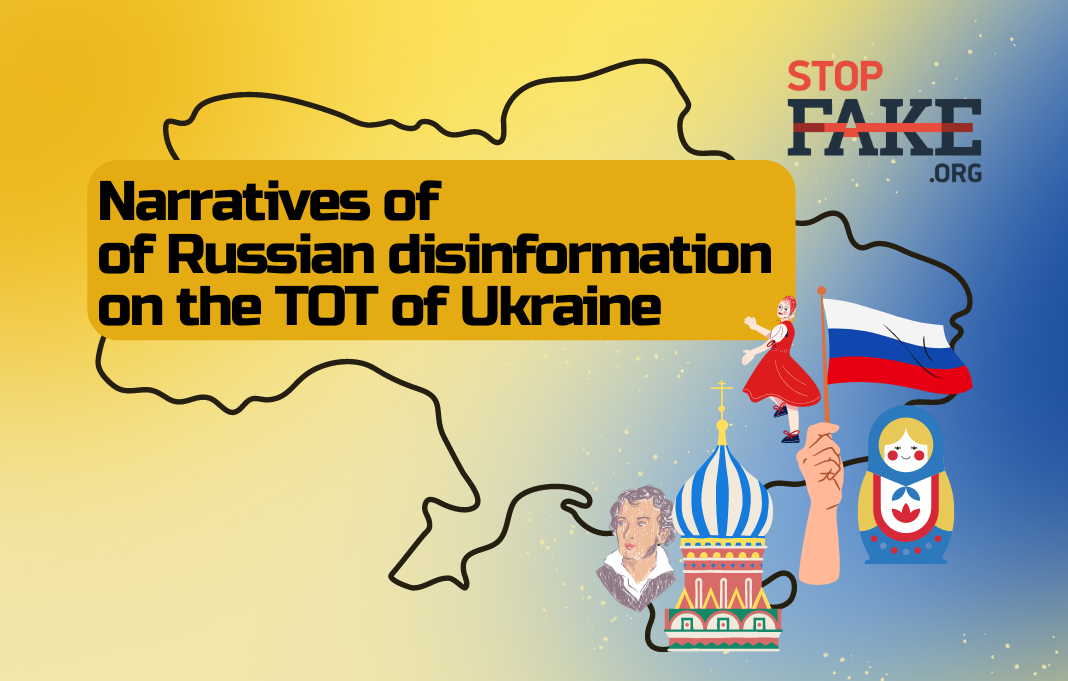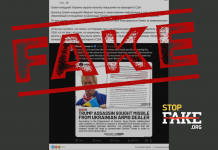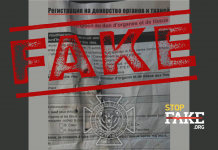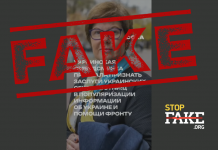In attempting to occupy Ukraine, Russia is primarily fighting to occupy the thoughts and decisions of Ukrainians. Wherever Russian troops arrive, one of the Kremlin’s first tasks is to occupy this information space and make its narratives dominant. In the temporarily occupied territories (TOT), Ukrainians – some for three years, others for 10 years – are forced to live in the occupied information space. StopFake journalists have analyzed which disinformation narratives are most commonly found in propaganda resources operating in temporarily occupied territories.
The algorithm of Russia’s actions in the information space in the temporarily occupied territories is quite clear: domination and exclusion of any other point of view other than the Kremlin’s. For example, in 2022 alone, Roskomnadzor blocked about 250 websites with “anti-Russian propaganda” in the occupied regions, and in fact, blocked access to Ukrainian news sites, declaring them hostile. At the same time, about 105 new media outlets were registered. And these numbers are only growing, as Russia is working on the formation of distinct media holdings that will work to spread propaganda among Ukrainians in the temporarily occupied territories. One such example is the creation of the Novoe.media holding, which was launched in the spring of 2024 and whose editorial office is located in the Russian city of Rostov-on-Don. Of course, there is no chance for the existence of Ukrainian media under occupation – such journalists are persecuted, imprisoned, intimidated, and forced to work in exile. Instead, Russia is doing everything possible to attract both local youth and Russians to work in its media, promising free housing and high fees.
An illustrative fact of the occupation of the information space by Russia is the distribution of free satellite television under the telling name “Russian World”, where the package includes “necessary channels”. At the same time, any other equipment that helps to hear and see Ukrainian media can be forcibly confiscated.
For the monitoring, we selected 5 news resources that are the most popular in the temporarily occupied territories in terms of the number of subscribers or website traffic. These are the Telegram channels “MLNR Luhansk News,” “Mariupol is ours,” “Zaporizhzhia Vestnik,” as well as the websites “Novoe.media” and “V Zaporizhzhia.” For the analysis, we monitored the news feeds of these resources in April-May 2024. Among the main narratives that prevail in these resources, we identified the following: “entire Russia is rebuilding new regions that are now forever part of the Russian Federation”, “before Russia appeared in the temporarily occupied territories, no one built, made or developed anything”, “there is a revival in the occupied regions, in Ukraine, there is chaos and war “to the last Ukrainian”, “the Armed Forces are “Kyiv fighters”, “terrorists and executioners”, “Ukrainians who want to help the “executioners” will be severely punished”.
“The entire Russia is rebuilding the regions that are now forever part of the Russian Federation”
The main narrative that dominates the occupied information space in the temporarily occupied territories is that Russia has brought reconstruction and revival. Therefore, most of the news tells about how these regions are being restored and completely omits the fact that it was Russia who brought the war to these regions and caused the destruction and decline. In addition, the Kremlin emphasizes that this reconstruction is being carried out by the joint efforts of Russians who “voluntarily” go to these regions to “lend their friendly shoulder.” Such news also describes various aid campaigns such as “Russian Word for Zaporizhzhia,” where different regions collect Russian literature and send it to the temporarily occupied territories, or about doctors from Russia who go to treat Ukrainians in the occupied territories.
Screenshot – vzaporozhye.ru
Screenshot – vzaporozhye.ru
Screenshot – vzaporozhye.ru
Screenshot – novoe.media
Screenshot – Telegram-канал @mariupol_nash
This narrative aims to legitimize the illegal occupation of Ukrainian territories by presenting it as a “reunification” with Russia, and that the fraternal people are always ready to help, to create a sense of support for the Russian invasion among Russians themselves, who are ready to go to the occupied territories en masse and voluntarily, to hide the scale of destruction and crimes committed by Russian troops, showing Russians as liberators and rebuilders.
“Before Russia appeared on the temporarily occupied territories, no one built, made or developed anything”
The other narrative is that it was with the arrival of Russia that these territories finally began to be restored and developed. Here, the theses are promoted that all these objects were previously forgotten by Ukraine, that no houses were built before Russia came, or that objects are being built at a rapid pace that has never happened before. This narrative is aimed at discrediting the role of Ukraine and Ukrainians in the development of these regions before the invasion, shaping the role of Russia as a “benefactor” who brought prosperity to these territories, and reinforcing the narrative of the unity of these territories with Russia and their “alienation” from Ukraine.
Screenshot – novoe.media
Screenshot – novoe.media
Screenshot – novoe.media
“in the ‘new regions,’ there is a renaissance, in Ukraine there is chaos and war “to the last Ukrainian”
At the same time, Russian disinformation is actively working to give Ukrainians living in the temporarily occupied territories the impression that chaos, terror, human rights violations, Nazism, and even “cherries are sold for 1000 UAH per kilogram” are taking place in unoccupied Ukraine. All this is accompanied by a common thesis: “Do you want this to come to your house?” Such narratives are intended to justify Russia’s invasion of Ukraine and show that Ukraine is a failed state, unable to take care of its population, unlike Russia.
Screenshot – Telegram-канал @zpvestnik
Screenshot – Telegram-канал @mariupol_nash
“The Armed Forces of Ukraine are ‘Kyiv militants’, ‘terrorists and punishers'”
Also, against the backdrop of narratives about the Russian army, which is shown as an army of heroes and saviors, the AFU is presented exclusively as “militants, punishers, terrorists” who attack only civilians. For Mariupol, “evidence of war crimes of the Ukrainian Armed Forces” is actively covered separately, with various people repeating on camera the propaganda narratives that the Ukrainian Armed Forces used people as human shields, that it was the Ukrainian army that destroyed the city, and that it held children prisoner. This narrative works to demonize the Ukrainian army and justify any actions of the Russian army.
Screenshot – vzaporozhye.ru
Screenshot – vzaporozhye.ru
Screenshot – vzaporozhye.ru
Screenshot – Telegram-канал @mariupol_nash
Screenshot – Telegram-канал @mariupol_nash
Screenshot – novoe.media
“Ukrainians who want to help the ‘punishers’ will be severely punished”
We should also mention the narrative that aims to intimidate the local population and prevent them from offering any resistance to the occupiers. The news that those who want to help Ukraine are being monitored, caught, and severely punished in the occupied regions is constantly present in the information space, accompanied by videos showing interrogations or operations to detain a “spy.”
Screenshot – Telegram-канал @zpvestnik
Screenshot – Telegram-канал @zpvestnik
Screenshot – Telegram-канал @mariupol_nash
Screenshot – vzaporozhye.ru
For example, the news that a Ukrainian citizen could be sentenced to 20 years in prison for helping an “enemy state,” where “enemy state” means Ukraine, is absurd. Nevertheless, this news sounds logical in the Russian picture of the world.
So, we can conclude that Russia is actively working to accustom Ukrainians to the idea that there will be no de-occupation, and they need to adapt – to get Russian passports, to get used to a different reality. At the same time, Ukraine and the Ukrainian army are portrayed as an enemy that threaten peace, stability, and development, and anyone who wants to help them is a traitor. Given the fact that access to objective information in the temporarily occupied territories is virtually non-existent and requires complicated steps, and may threaten security, Ukrainians are simply forced to live in the enemy’s information space, where their right to access information is violated. This is certainly another war crime Russia should be held accountable for.
Author: Olena Churanova





